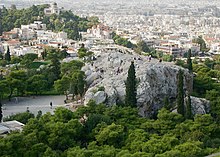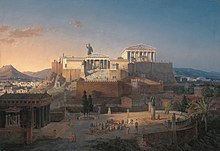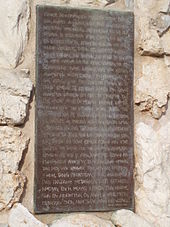Areopagus
The Areopagus , also Areopagus (os) , (from ancient Greek Ἄρειος πάγος Arios Pagos , German , Ares rock or -hügel ' ) is a north-west of the Acropolis situated, 115 meters high rock in the middle of Athens . In ancient times the supreme council met here , which was also called "Areopagus". The council was the oldest body in town; its history goes back to the mythical early days of Athens.
The legend of the origin of the marathon also has its climax on the Areopagus: after the Athenians had triumphed over the Persians in the battle of Marathon , a messenger is said to have run from Marathon to Athens and died on the top of the hill after the victory was announced. Historically, however, this representation is controversial and is therefore usually classified as a legend .
mythology
According to mythology , the Supreme Council of Areopagus was founded when Ares killed Halirrhothios, who had molested Alcippe , the daughter of Ares and Aglauros . Ares was now accused by Poseidon , the father of Halirrhothios. But since there were no witnesses and Alcippe and Ares made identical statements, he was acquitted in this first trial of a homicide .
Later represented Apollo in the cause of Orestes before this Court, as this at the behest of God his mother Clytemnestra had killed in order the murder of his father Agamemnon to avenge. Prosecutors here were the Erinyes and the spirit of Clytemnestra, presided over by Athena . When there was a tie in the verdict, the father's daughter Athene decided in favor of Orestes, as the mother had deserved death by murdering her husband together with her lover - an interpretation of the law that the Erinyes disliked. Orestes was acquitted, but they continued to persecute him until, on the advice of Apollo, he brought a sacred image of the goddess Artemis to Greece from the land of the Taureans .
Place of jurisdiction
The Areopagus was initially composed of leaders of the high nobility and from the time of Solon in the 6th century BC. From former archons (representatives of the highest civil service). He was in charge of state supervision over Athens. This view, strongly influenced by the Aristotelian conception of the constitutional development of the Greeks, is increasingly coming under criticism because no reference to a “second” or noble council could be found in the inscriptions of the draconian laws or in other archaic sources.
In addition to sacred tasks, the Areopagus was entrusted with administrative and government duties; however, he was primarily responsible for blood jurisdiction . His judgments were irrevocable, so he had an important power in the Attic constitution . As a result of the reforms of Solon, who opposed the Areopagus the Bule ( council of 400 ), as well as those of the Ephialtes , the 462 BC. BC the tasks of the Areopagus were largely restricted to the sacred and kinship areas such as blood jurisdiction, and during the reign of Pericles the influence of the Areopagus was more and more curtailed. A distinction must therefore be made between the competencies of the Areopagus before Solon, after Solon and after Ephialtes. The tasks of the Areopagus were taken over by the Bule, the Heliaia (jury) and the Ekklesia (popular assembly). A distinction must also be made between the formal influence, which was increasingly withdrawn from the Areopagus, and the informal influence which it had because of the great political experience of the people gathered in it. In this way, Areopagus was able to acquire a considerable wealth of expertise in times of crisis.
Mention in the Bible
The Apostle Paul is projected by the Acts been in an Athens visit of residents led to the Areopagus be ( Acts 17:19 EU ff.), So there he explain his "new doctrine". The interpretation of the location in the Bible is controversial, because the Areopagus as a body no longer met on the rock of the same name since classical times, but in the King's Hall ( Stoa Basileios ) on the agora . “Areopagus” may therefore refer to the place or the appropriate council.
today
Today the Areopagus ( modern Greek Άρειος πάγος Ários págos ) is the supreme court of Greece . This no longer meets on the Areopagus Hill, but in the Palace of Justice Themidos Melathron on Alexandras Boulevard after he was in the Iliou Melathron from 1934 to 1981 .
literature
- Hermann Bengtson : Greek History. From the beginning to the Roman Empire. Special edition (full text without comments and bibliography), 9th, unchanged edition. CH Beck, Munich 2002, ISBN 3-406-02503-X .
- Hans Rupprecht Goette , Jürgen Hammerstaedt : Ancient Athens. A literary city guide. Beck, Munich 2004, ISBN 3-406-51665-3 .
- Michael Grant , John Hazel: Lexicon of ancient myths and figures (= dtv 32508). 19th edition. Deutscher Taschenbuch-Verlag, Munich 2008, ISBN 978-3-423-32508-0 .
- Robert von Ranke-Graves : Greek Mythology. Sources and interpretation (= Rowohlt's encyclopedia. Vol. 404). Authorized German translation by Hugo Seinfeld with the assistance of Boris von Borresholm based on the American Penguin edition published in 1955. 18th edition, new edition in 1 volume. Rowohlt, Reinbek near Hamburg 2011, ISBN 978-3-499-55404-9 .
- Richard Speicher: Southern Greece I. Athens, Attica, Boeotia, Phocis, Phthiotis and Euboea. Kohlhammer, Stuttgart 1978, ISBN 3-17-004690-X .
- Kurt Wachsmuth , Theodor Thalheim : Ἄρειος πάγος . In: Paulys Realencyclopadie der classischen Antiquity Science (RE). Volume II, 1, Stuttgart 1895, Col. 627-633.
Web links
Individual evidence
- ^ Richard Speich: Southern Greece I. Athens, Attica, Boeotia, Phocis, Phthiotis and Euboea, p. 104
- ^ Hans Rupprecht Goette, Jürgen Hammerstaedt: The ancient Athens. A literary city guide, p. 155
- ↑ Libraries of Apollodorus 3, 14, 2
- ↑ Aeschylus , The Eumenides
Coordinates: 37 ° 58 ′ 20 ″ N , 23 ° 43 ′ 25 ″ E


